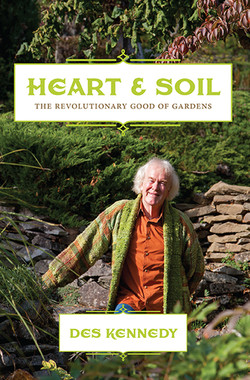Читать книгу Heart & Soil - Des Kennedy - Страница 14
На сайте Литреса книга снята с продажи.
ОглавлениеMushroom Magic
Every year it seems there are more and more mushrooms popping up at our place—spring morels in the vegetable patch, oyster mushrooms on old alder logs, fairy rings circling in the lawns and various unidentified fungi in undisturbed corners. I used to believe that having mushrooms in the garden was, like cockroaches in the house, a shameful thing, revealing one’s lack of cleanliness and moral rectitude. But I’ve come full circle (the correct direction to come when dealing with fungi) and now rejoice to see mushrooms of all types fruiting wherever they will.
We’ve long appreciated the role of fungi as decomposer organisms in the woodlands that surround our yard—the tactical brilliance with which a succession of different fungi consume rotting logs and other forest debris, helping turn the corpse of an ancient tree into the soil from which a new generation of trees will spring. Then, a couple of decades ago, progressive foresters in the Pacific Northwest began publicly discussing how crucial some fungi are to healthy forests because of what is called their mycorrhizal characteristics, indicating a symbiotic association between trees and fungi. This is a mutually beneficial (or sometimes mildly pathogenic) relationship in which the tree’s rootlets become sheathed in fungal hyphae that take on the role of root hairs, extending and vastly increasing the tree’s ability to absorb nutrients from the soil. The fungus shares with the tree the foods it produces through enzyme digestion of organic matter, and in turn the tree shares with the fungus the foods it produces through photosynthesis. Forests with extensive mycorrhizal networks have been shown to be far healthier and more productive than areas where heavy-impact forestry has destroyed the magic fungal network underground.
Specialty gardeners have traditionally known that other plants enjoy similar associations with specific fungi, the degree of intimacy varying with different classes of plants. Orchids, for example, simply cannot be raised without the right fungus active in their soil (the mycorrhizal fungus must penetrate the cells of the orchid seeds before they can germinate). So the question naturally arises: Would more, perhaps even most, of our garden plants benefit from having mycorrhizal fungi around their roots? And, if so, what changes in gardening technique would we have to implement?
For an unequivocal opinion on these questions, we need look no farther than Washington state, where mycologist Paul Stamets has evolved into something of a mycelial shaman, promoting the benefits of fungi for everything from personal health to toxic-waste remediation. An intriguing combination of scientist, prophet and entrepreneur, Stamets passionately advances the rationale of gardening in cooperation with fungal allies. He believes some 90 percent of plants benefit from reciprocal relationships with fungi, a relationship that protects the plant from disease and enhances its ability to absorb water and nutrients. By clearing and constantly ploughing up land, he maintains, we destroy these vital fungi, thereby short-circuiting the plant’s natural growth mechanisms and requiring that we promote plant growth through fertilizers and other artificial means. Reintroducing mycorrhizal fungi to the soil, he says, will promote faster growth, speed transplant recovery and reduce the need for fertilizers and other additives. Several companies, including Stamets’s mail-order operation, Fungi Perfect, now market a number of specialized mycorrhizal-fungus products for the home gardener, ranging from mixtures for use in potting soil to products used directly on seeds.
If visionary mycologists like Stamets are correct in their assertions—and my forest-sharpened instincts incline me to believe that they are—the implications for our gardening are enormous. The first activity we’d want to curtail is this endless digging and rototilling of soil which, no matter how soul-soothing, plays havoc with any mycelial threads in the ground—not to mention greatly inconveniencing earthworms, beneficial predators like ground beetles and centipedes and innumerable micro-organisms. Personally, I have a deep metaphysical attachment to the rituals of spading (something I’ll expound upon later in this volume) so going cold turkey is a drastic measure I’m disinclined to entertain, at least for the moment, but I see it advancing upon me.
We’d move instead toward a no-till system, constantly applying to the surface fresh organic matter that cooperative fungi and other organisms would transform into soluble food for our plants. Who knows, we might also incorporate edible mushrooms into our plantings—maybe the garden oyster mushroom, Hypsizygus ulmarius, which can unlock nutrients from straw, sawdust and organic debris, feeding the roots of underlying plants and producing gourmet mushrooms at the same time. Talk about a win-win.
So, yes, notwithstanding all the gloom prevalent in this imperfect world, it’s possible to imagine bright days ahead, lazy days when we may set aside our spades, relax our aching bods and dance together merrily among the fairy rings of magical mushrooms.
